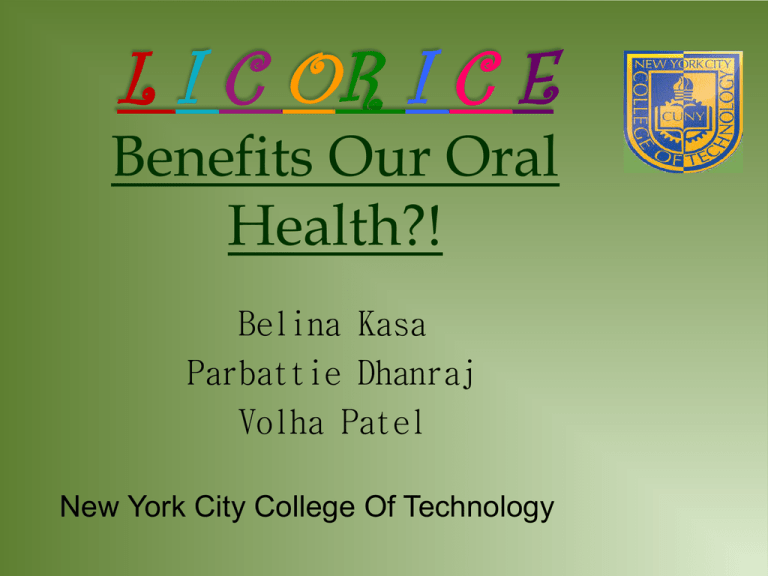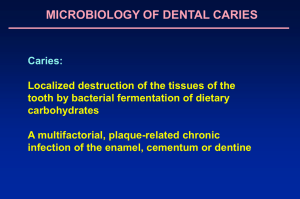Licorice Presentation GNYDM
advertisement

L I C OR I C E Benefits Our Oral Health?! Belina Kasa Parbattie Dhanraj Volha Patel New York City College Of Technology What is LiCorIcE? Licorice, or Liquorice, is a unique tasting herb derived from Glycyrrhiza glabra (a.k.a. Sweet Root), pea family. The edible and sweet root of licorice has been used in food and medicine for thousand years. Licorice is available to consumers in forms of liquid extract, dried solid root and root powder, licorice tea, candy. http://www.herbal-supplement-resource.com http://www.ayurvedicdietsolutions.com Active Ingredients And Properties Active chemical ingredients imparting the unique liquorice taste are glycyrrhizic acid and glycyrrhizin, which are 50 times sweeter than sucrose, inhibit the adherence of bacteria to teeth Licoricidin and licorisoflavan A are strong antimicrobials that prevent the growth of bacteria and have antifungal properties PRECAUTIONS Excessive, regular consumption (50grams a day or more) of concentrated licorice extract may be toxic to the liver and cardiovascular system, and may produce hypertension and edema. Take precautions and ask your physician if licorice is safe for your health. What is CARIES? • Dental caries – a complex and chronic disease that is associated with a progressive destruction of the hard tooth structures by the action of biofilm bacteria (specifically Streptococcus mutans and Streptococcus sobrinus). http://www.reahim-minsk.com How Licorice Affects Caries? Reduces dental caries by antibacterial activity against the cariogenic bacterium Streptococcus mutans Impacts the dental caries by stimulating salivary flow, which protects, cleanses and helps to remineralize teeth Bioactivity of Glycyrrhizin Sugar-free Lollipops Against Cariogenic Bacteria, S. mutans Figure 2 Time killing assay. Bioactivity of lollipops against cavity-causing bacteria S. mutans planktonic cells. Diluted S. mutans were exposed to TH broth (group I), 0.125 g·mL-1 lollipop placebo (group II), 0.25 g·mL-1 herbal lollipop (group III) and 1 g·mL-1 herbal lollipop (group IV) for 1, 5, and 10 min. Survival rates (%) were calculated by dividing surviving CFU per milliliter of each lollipop solution by surviving CFU per milliliter of TH broth. Data represents averages of the results of three independent experiments. www.ijos.org.cn | International Journal of Oral Science Other Beneficial Factors of Licorice On Oral Health speeds healing of mouth sores by limiting irritation to the damaged tissue reduces dental caries by anti-bacterial activity against the cariogenic bacterium S. mutans therapeutic for treating oral candidiasis by inhibiting to grows of Candida albicans has potential to inhibit growth and formation of biofilm by acting on periodontal pathogens References 1. Comprehensive periodontics for the dental hygienists/ Mea A. Weinberg, 3rd edition, 2010. 2. Oral Diseases Journal, Vol 18, 2012. ‘Licorice and its potential beneficial effects in common oro-dental diseases’ by C. Messier, F. Epifano, S. Genovese, D. Grenier. 3. http//www.emaxhealth.com Licorice Lollipops May Reduce Tooth Decay in Kids, by D. Mitchell 4. http//www.ncbi.nih.gov Liquorice Health Check, Oro-Dental Implications, and a Case Report by Louis Z. G. Touyz 5. http//www.thecheckup.com Licorice Root could Help Prevent Tooth Decay, by S. Wright 6. http//www.medicinenet.com Licorice Root May Cut Cavities, Gum Disease, by Matt McMillen











